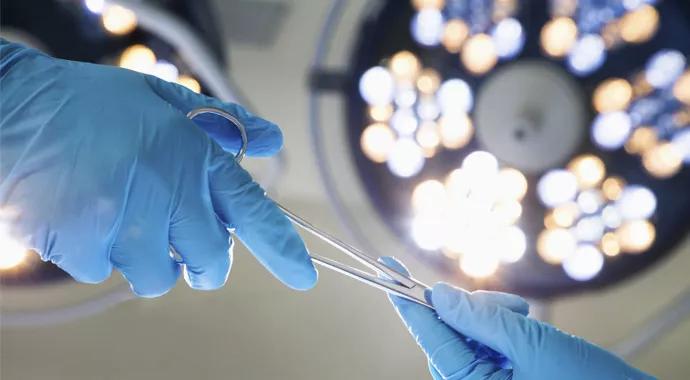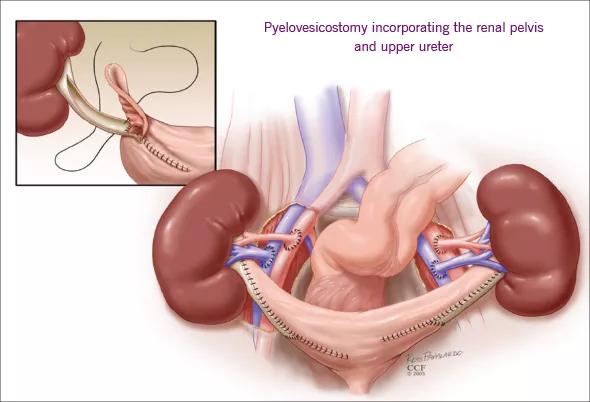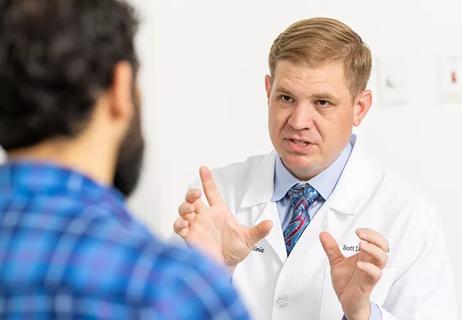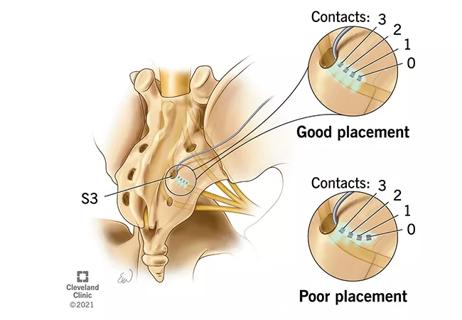Renal autotransplantation and pyelovesicostomy provides relief for select patients

By Stuart M. Flechner, MD, FACS, and Mark Noble, MD
Cleveland Clinic is a non-profit academic medical center. Advertising on our site helps support our mission. We do not endorse non-Cleveland Clinic products or services. Policy
Kidney stone disease or nephrolithiasis is common, with nearly 1 in 11 individuals in the United States experiencing a stone event at some point in their lives. At least 50 percent of individuals experience another stone within 10 years of the first occurrence.
A small subset of these patients has identified metabolic abnormalities that cause a wide spectrum of stone events ranging from the spontaneous passage of small stone debris or gravel, causing minor symptoms, to frequent, painful calculi that do not pass easily, sometimes resulting in sepsis and loss of renal function.
The etiology of these metabolic stone diseases includes calcium oxalate, cystinuria, renal tubular acidosis, calcium oxalate and uric acid, and medullary sponge kidney. The more severely afflicted patients require frequent radiologic imaging of the urinary tract plus a variety of urologic interventions including ureteral stents, nephrostomy tubes and percutaneous nephrostolithotomy, extracorporeal shock wave lithotripsy, ureteroscopy with lithotripsy, or open surgical extraction of stones. Some patients report passing more than 70 stones during their lives.
For many of these patients, standard treatments will be inadequate to control the burden of their stone-related symptoms. Such patients may become dependent on chronic narcotics for pain relief, and for many, the metabolic stone burden becomes the driving force in their lives, interfering with daily activities, family life and well-being.
To address the problem of intractable metabolic stone disease with narcotic dependence, we offer patients a surgical option of replacing their ureter, which is the narrow point in the urinary tract that causes most of the symptoms during stone passage. We remove the kidney and all visible stones, perform a renal autotransplantation, and create a bladder tube, or modified pyelovesicostomy, to permit subsequent passage of stone debris (Figure 1).

Figure 1. Renal autotransplantation to the iliac fossa and creation of a modified pyelovesicostomy for subsequent stone passage.
It was anticipated that the procedure would result in (1) renal denervation to reduce pain, (2) near complete removal of stone debris while the kidney was ex vivo, (3) replacement of the ureter with a wide channel for future stone passage and (4) creation of an easier route to the kidney with endoscopic instruments if needed. In theory, vesicorenal reflux to wash out small stone granules would also likely occur over time.
Although this surgical approach alters the anatomy and ability to pass subsequent stones, it would not alter the metabolic derangements that cause stone formation.
Candidates for this procedure undergo the following assessments
(Figure 2):

Figure 2. Evaluation of patients with intractable nephrolithiasis.
Patients are selected for this approach only if there is a high likelihood of successful rehabilitation and future medical compliance and follow-up.
During the past nine years, we have autotransplanted 28 kidneys in 22 patients (six bilateral), with resolution or improvement in chronic pain in all. About half of these patients continue to pass stone gravel that is usually painless. About one-third have had a subsequent procedure to remove a stone during a five-year interval. However, the stone treatment rates, even in those with cystinuria, were dramatically reduced from as many as 10 procedures a year to less than one every few years. The preoperative mean estimated glomerular filtration rate was 77.2 cc/min; postoperatively it was 73.5, 71.9 and 79.2 cc/min at 12, 36 and 60 months, respectively.
None of these procedures was performed for the sole purpose of stone removal. This aggressive surgical approach should be limited to carefully selected patients who meet strict criteria and for whom success can be reasonably predicted. Proper selection requires a team approach for the evaluation of candidates, including urologic surgeons, physicians, nurses, pain management specialists and psychiatrists.
Renal autotransplantation and pyelovesicostomy can offer patients with intractable metabolic stone disease the opportunity to improve their quality of life and decrease daily narcotic use.
Dr. Flechner is a staff member of Cleveland Clinic’s Glickman Urological & Kidney Institute and of the Transplantation Center. He is a Professor of Surgery at Cleveland Clinic Lerner College of Medicine. Dr. Noble is Surgical Director of Stone Disease at the Glickman Urological & Kidney Institute.
Flechner SM, Noble M, Tiong HY, Coffman KL, Wee A. Renal autotransplantation and modified pyelovesicostomy for intractable metabolic stone disease. J Urology. 2011; 186:1910-1915.
Pearle MS, Goldfarb DS, Assimos DG, et al. Medical management of kidney stones: AUA Guideline, 2014.

Review the advantages and disadvantages of newer interventions

Pioneering and refining the approach in pyeloplasty, nephrectomy and more

Unlike earlier pills, new drugs do not cause liver toxicity

Male factors play a role in about half of all infertility cases, yet men often are not evaluated

Hadley Wood, MD, shares her vision as the new editor-in-chief of Urology

Study leverages data from the ROSETTA trial

More on the procedure and the institutional experience

Explain some, but not all, of lower utilization